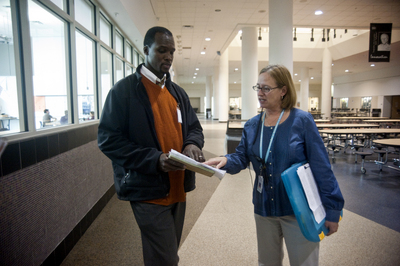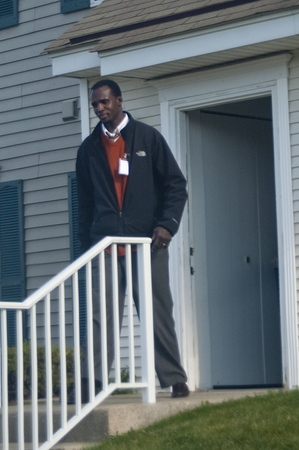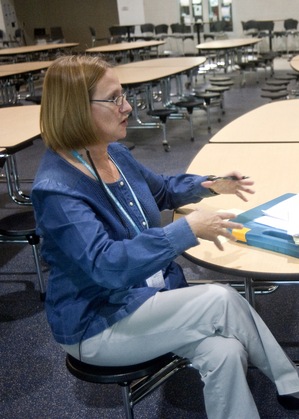
Ann Arbor Public Schools truancy officer Derrick Padgett spends much of his day making phone calls and driving around to schools, sometimes simultaneously, to check up on students with attendance issues. He also makes home visits in rare cases or to talk to parents.
Joseph Tobianski | AnnArbor.com
Derrick Padgett pulled his car out of the mobile home park.
The stop had been a bust. The unit number he was looking for didn't exist.
Padgett began racking his brain.
"Well, there's one more place she could be," he said.
Her home.
Padgett is the truant officer at Ann Arbor Public Schools, although he's not particularly fond of the title. Often, families think he's some sort of cop, there to haul their children off to school or to ticket them for skipping.
But Padgett doesn't put students in the back seat of his car, nor does he issue tickets or report students to the court system. In fact, Padgett said surprise house calls, like this one, are rare, and reserved for those kids with severe, ongoing truancy problems — or "the chronic cases."
On this particular Wednesday, Padgett had hoped to check in with Jackie, a student at one of Ann Arbor's three comprehensive high schools, whom teachers and staff hadn't seen in class for about three days. Jackie had been staying with an older boyfriend in an Ann Arbor mobile home park.
Padgett got the unit number from Jackie's mom. He doesn't know whether the incorrect information was on the part of Jackie, so her mom couldn't find her, or on the part of a desperate mother, who was trying to protect her daughter and regain her daughter's trust.
But these are just a few of the things Padgett has to deal with in his job: he-saids, she-saids about where a child was and why.
When Jackie's mother opened the door to the home the two share across town, Padgett peered down the hallway at the glimmer of broken glass sprinkled about the floor. Nearby, he noted an upturned table lamp and a punctured wall. Jackie was sitting at the kitchen table.
Jackie and her mother had just returned home from the hospital, where Jackie had been admitted for overnight care in the psychiatric emergency ward.
Tracking truancy
In Michigan, a student is considered truant when he or she has accumulated 10 or more unexcused absences in a single school year. The role of a truant officer, in a general, is to work with teachers and school administrators in order to educate parents and students in the community on the importance of attending school.
"The goal always is to get a child to go to school," Padgett said, explaining he does whatever it takes to accomplish this goal. And "whatever it takes" varies drastically from student to student.
There is an abundance of probable causes and contributing factors that lead to truant behavior among youth: traumatic life experiences, language barriers, unidentified learning disabilities, low academics, undiagnosed vision or auditory problems, financial difficulties, child abuse or neglect, substance abuse, uninteresting curriculum, high student-to-teacher ratios, negative peer relationships and a lack of value placed on education by the child's parents.
At AAPS, Padgett said childhood depression and mental health issues like in Jackie's case are at the root of a surprisingly large percentage of students' chronic truancy problems. Or, sometimes the parent has mental health issues and the child stays home to help and to take care of his or her younger siblings, he said.
Padgett said honestly he was shocked to learn what an epidemic this is.
"I would've thought of a whole lot of other things before I would've thought of mental health issues leading to the bulk of attendance concerns at the high schools," he said.
But the mental health issues don't have to be as severe as Jackie's to impact a student's school attendance. Padgett said he works with a bright teen at Community High School who has anxiety due to some financial struggles his family is enduring.
"It's hard for him to sleep at night because of this anxiety, so he's sleeping during the day and not going to school," Padgett said, adding he referred the student to the Regional Alliance for Healthy Schools. "They can help him chart data to look at his anxiety and to self-monitor it...
"It's been a continuous cycle for this kid because if you're not sleeping, you become exhausted and worn down. The kid had signs of depression and then anxiety about missing school. And because of that anxiety, he started to avoid class and his school work, which only causes more anxiety..."
This is just the second year AAPS has had a full-time truant officer. Prior to Padgett taking on the role, there was a part-time person who handled the district's truancy cases. However, the former individual took a more traditional approach of lecturing kids when they ditched class; whereas Padgett, whose degree and previous experience in social work have helped him to expand the role, tries to correct and address the cause of the skipping, he said.

Skyline Community Assistant Cheryl Haller runs down a list of truant students with AAPS truancy officer Derrick Padgett and updates him on the students' attendance status and grades.
Joseph Tobianski | AnnArbor.com
AAPS spokeswoman Liz Margolis said Padgett has done some very valuable work for the district since taking on the position.
"His knowledge of the district from his years serving as a school social worker has allowed him to ... intervene prior to when a student is considered truant," she said. "His knowledge of the social service system and the court system has allowed him to be a critical liaison for the district and students who are or are approaching truancy."
"I'm like a bandage," Padgett said, explaining he pulls all of the elements of a child's life together into a package that hopefully will help solve some of the child's problems and help them graduate.
Margolis said the district plans to continue funding the position as a full-time position next school year.
The scope of the problem
In the 2011-12 academic year, 93,408 cases of truancy were reported in Michigan schools. This is an increase of nearly 10,000 from the previous year, which had 83,491 cases reported.
Padgett said this fall, he's had approximately 40 students in his caseload. But he said those 40 are chronic cases, or students he dealt with last year as well. Truancy issues typically don't pick up until after the first semester, he said. By January, his caseload could double or triple.
"That's when students get report cards and start noticing trouble with their grades," Padgett said. "That's when they stop wanting to go class because they think they can't succeed."
He added by this natural break also is when administrators and counselors start to get a better feel for which students are being bullied at school and skipping certain classes or failing one subject and avoiding just that class.
Padgett said there also are some parents who don't care that their children will not go school and who will call and make excuses for their kids. By second semester, the school secretaries can usually identify these families. Some families also abuse the state's homeschooling laws and the parent will say they are homeschooling their child, when really they aren't, Padgett said. The latter and other cases of parents failing to take their children to school are considered educational neglect.

Ann Arbor schools truancy officer Derrick Padgett makes a house visit.
Joseph Tobianski | AnnArbor.com
"She said if she dropped (Martha) off at school, she'd just skip anyway. So if (Martha's) home, mom doesn't have to worry. But I said that doesn't fly with me because the mom works, so she doesn't see (her daughter) anyway," Padgett said.
The 40 students currently on Padgett's caseload do not include children of homeless families, which is a demographic that traditionally struggles getting their kids to school. Homeless truancy issues are, generally speaking, passed along to the district's homeless liaison, Azibo Stevens.
Stevens works with these families to help them find temporary housing, resources and service agencies and transportation for their children, which school districts are legally required to provide free of charge.
Because last year was the first school year AAPS had a full-time truant officer, the district still is working out the kinks, Padgett said. He said when he started in this role, he was told to use PowerSchool, the district's attendance and grade reporting system, to monitor students' absences. Padgett also can view a child's schedule in case he needs to track the student down to speak with him or her.
However, frequently, teachers would not input their attendance into PowerSchool immediately at the beginning of the class period, making it difficult for Padgett to check in on his truant cases.
"Sometimes I'd call mom or dad and ask why Johnny wasn't in school, and they'd be like, 'What do you mean? He went to school today.' Then I'd go to the school and sure enough, there he'd be," Padgett said. "So that was part of the learning curve."
He said he mentioned this struggle and how it could cause additional unnecessary problems for a family to central administration. He said he believes central administration must have addressed it during professional development this fall because the teachers have been much better.
Padgett said most of his first year on the job was spent finding correlations between truancy and a student's family and academic life and various mental health issues. Finding these correlations has helped the district to identify more at-risk students and to implement preventative measures, he said.
"I have a network of people internally that I rely on at the schools to keep me informed of what's happening with a particular student on the day-to-day," Padgett said, adding his network consists of community assistants, counselors, principals and secretaries. "In my opinion, if a student is successful they're more apt to want to go to school, no matter what they've got going on at home. ... So those are the biggest things we monitor are grades."
Carrot on a stick
The Michigan Department of Human Services implemented a new policy this school year that's changed, in part, how truancy is viewed and dealt with.
As of Oct. 1, DHS now requires children ages 6 to 15 to attend school full time in order for their families to continue to receive cash benefits from the state. If a child does not attend school, the entire family can become ineligible for assistance.
Gov. Rick Snyder advocated for the new policy as a way to crackdown on the cycle of crime truancy creates.

Skyline High School community assistant Cheryl Haller discusses one student's attendance habits.
Joseph Tobianski | AnnArbor.com
Padgett also has concerns about how the loss of state aid will impact the truant child's overall health. Because mental health issues often are a contributing factor to truancy and a lack of food, clothing and shelter can be as well, he worries the truancy problems for families who lose aid will simply grow.
"Even if a parent loses benefits, it's these children of families who are disadvantaged that fall into the (truancy) cycle the most," he said. "It may just increase the problem and build up the (juvenile) court system even more."
The DHS policy itself is confusing, Padgett said, adding he has contacted the state a number of times to find out if schools are legally obligated to report the names of families with truant children to DHS. But he has not heard back, he said.
Currently, Padgett threatens to turn families in only as a last resort.
"But sometimes I will tell them, 'Listen, I'm hear to help you avoid that (losing the cash benefits), but there is this new law and you got to get your kid to school or it could happen,'" he said.
The Juvenile Court of Washtenaw County also has a program to address truancy, called the Status Offense Diversion Program.
It serves students ages 6 to 17 who are referred to juvenile court for non-delinquent behavior, which could include incorrigibility, running away, school truancy and educational neglect by the parents, according to its website.
Juvenile Court Probation Supervisor Donna White said there are two diversion officers who primarily operate the program. When a child is referred, an officer schedules a meeting with the family and schedules a time to visit the school.
At the meeting, the officer talks to the child and the parent or guardian about the importance of education and tries to establish an informal contract between the family and the court system.
"Essentially, everyone signs a document stating the child will go to school," White said. "Sometimes, just the parents knowing somebody is looking motivates them. And the kids are often intimidated by the court. The aura of the court sometimes brings about change in kids."
White said the diversion officers provide supervision and monitor the family for a semester. Like Padgett does, the diversion officers also try to connect the families with government agencies and outside resources, like Community Mental Health, she said.
"One family might need an alarm clock or maybe the kids are too embarrassed to go to school because they don't have clothing or clean clothing," she said.
Padgett said because the court's Status Offense Program is either a case where it works or it doesn't, he does not send many families to this program. If he does, the children are most likely juniors or seniors who need a quick turnaround to prevent them from dropping out and to get them to graduate.
If it is not successful, it can turn students and parents off to the idea of receiving other forms of help, Padgett said.
At AAPS, Padgett's focus is primarily freshmen and sophomores.
"These are often the grades that find it too easy to skip. And they are also the ones that if you address it early, can turn it around," he said. "The goal is creating successful students" and productive future citizens.
'The rooster call'
Padgett's greatest defense against a truant teen is something he has dubbed "the rooster call."
"I think because it's annoying," he said with a chuckle. "No kid wants to be called by some old dude every morning and told to get up."
Padgett's workday starts at 6 or 7 a.m. with these infamous rooster calls.
He said he spends about an hour every morning calling certain students with attendance issues to wake them up for school or in some cases, especially in the elementary grades, to wake up students’ parents.
Padgett said the rooster call can be very effective with the single moms because they often hear Padgett interacting with his own children, who are usually getting ready for school at about the same time and can be heard in the background.
Padgett said when he arrives at his office at the Balas Administration Building, he spends time searching PowerSchool to see if any of his truant students are absent.
Typically, he rotates every other day which buildings he attends to. For example, if Monday is the northwestern half of the district, Tuesday is the southeastern portion.
The majority of Padgett's mornings involve making phone calls to school buildings to check up on students and to speak with counselors, community assistants, coaches and his other "eyes and ears."
After this, he makes the rounds, usually trying to stop at one of the comprehensive high schools at lunchtime.
Food is the great equalizer, and Padgett said students need to eat. Sometimes students will come "out of hiding" to get their free or reduced lunch, he said. He also said the cafeteria is a comfortable place for kids, so it’s easier to approach them.
Skyline community assistant Cheryl Haller said Padgett knows his students and how to talk to them in ways that won’t turn them off.
"He does a good job of that," she said. "Let's be honest, he has a tough job. But he's made a significant impact. A critical point with some of these kids is getting them into the building. But you can’t just do that and expect it to be good enough or for everything to be better.
"Derrick does a good job of lining everybody up — us community assistants, teachers, counselors, the whole group."
Danielle Arndt covers K-12 education for AnnArbor.com. Follow her on Twitter @DanielleArndt or email her at daniellearndt@annarbor.com.